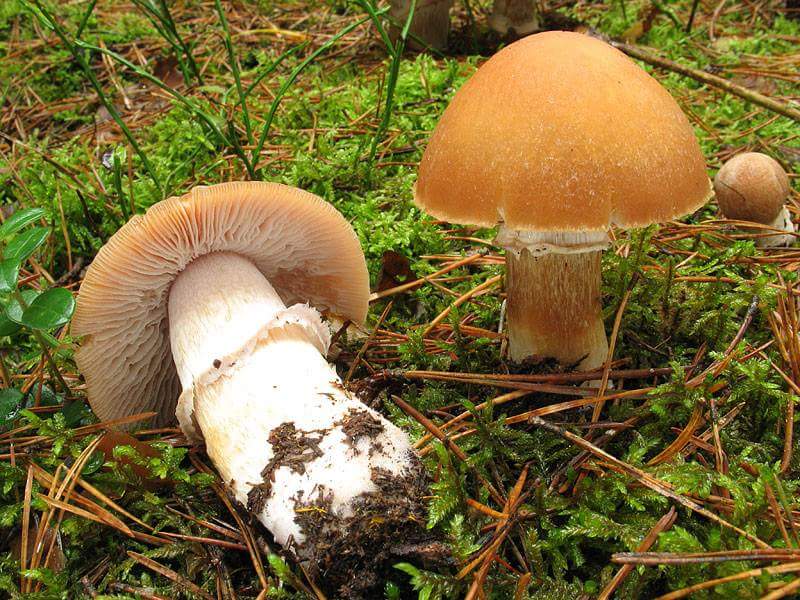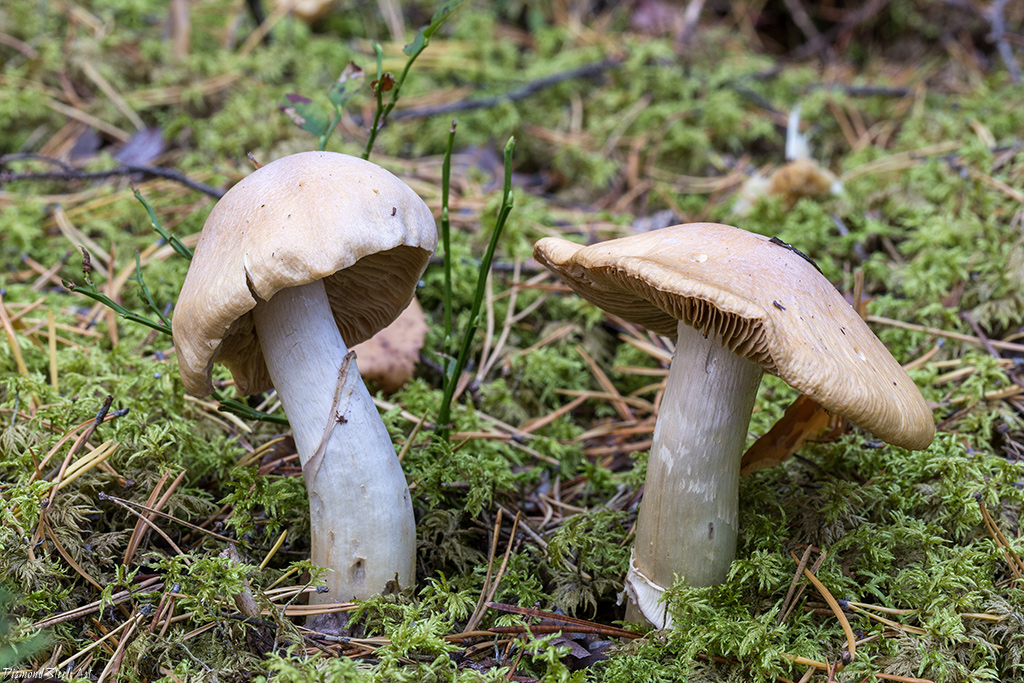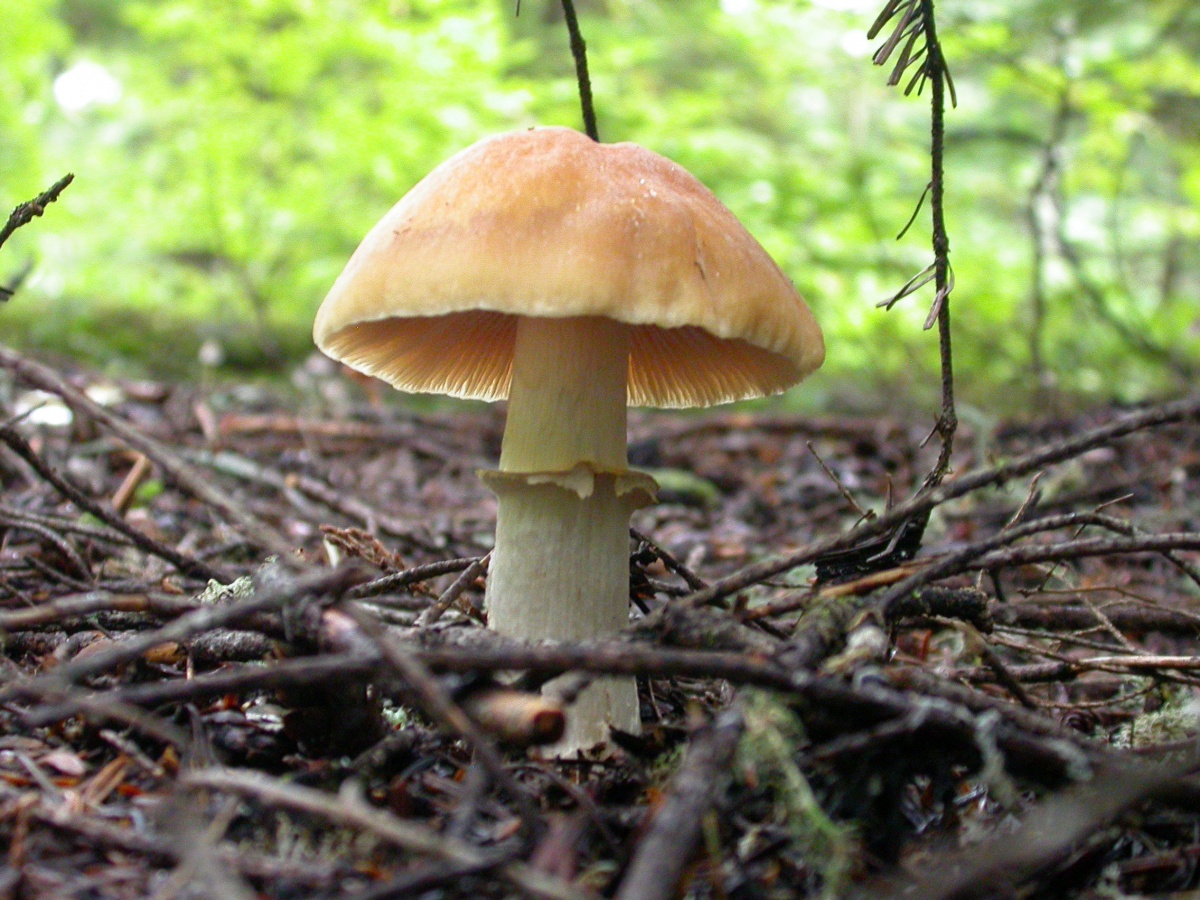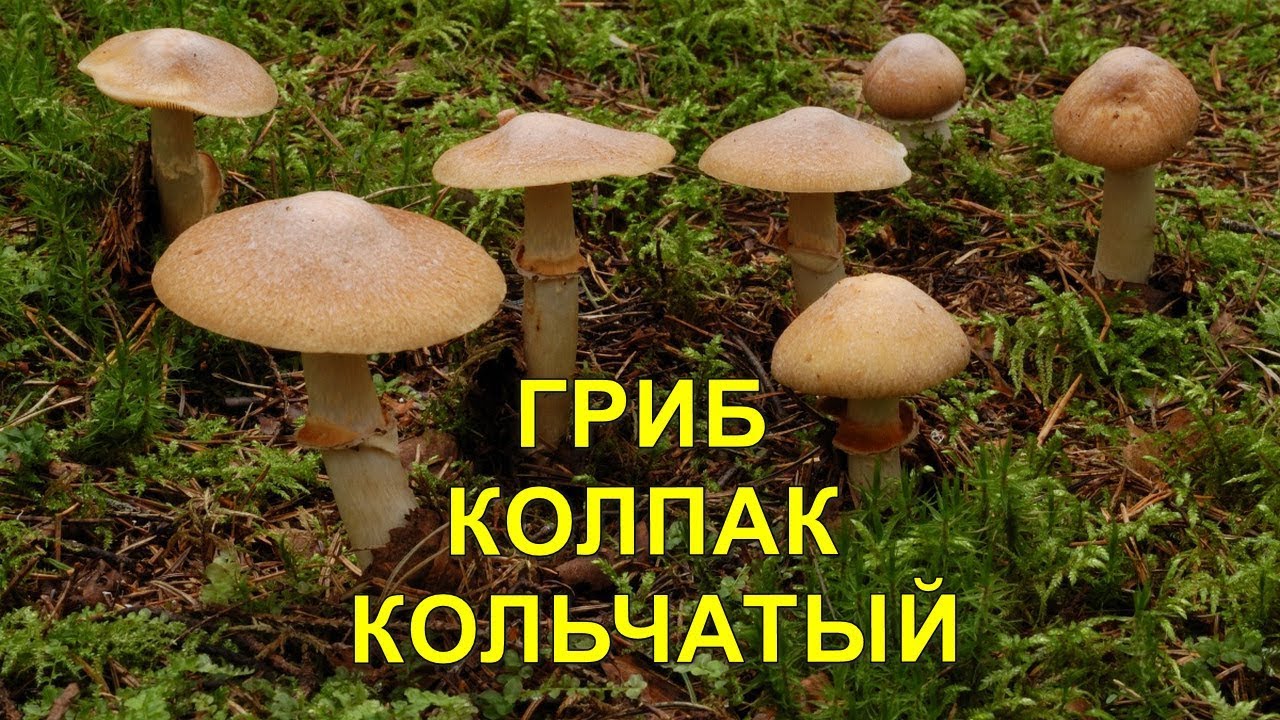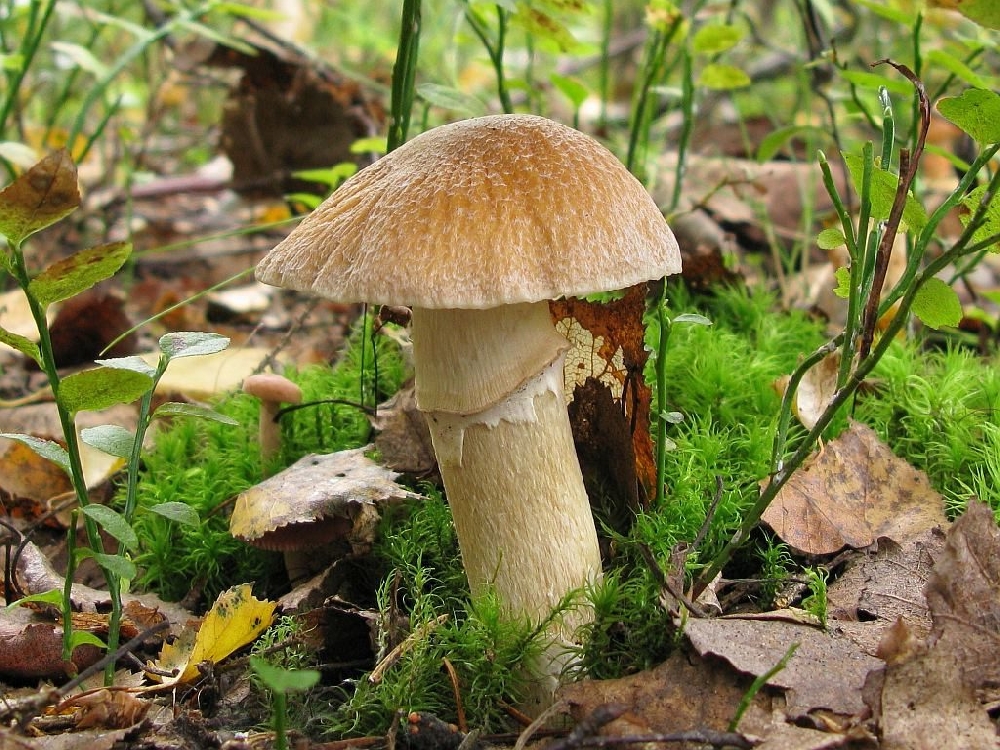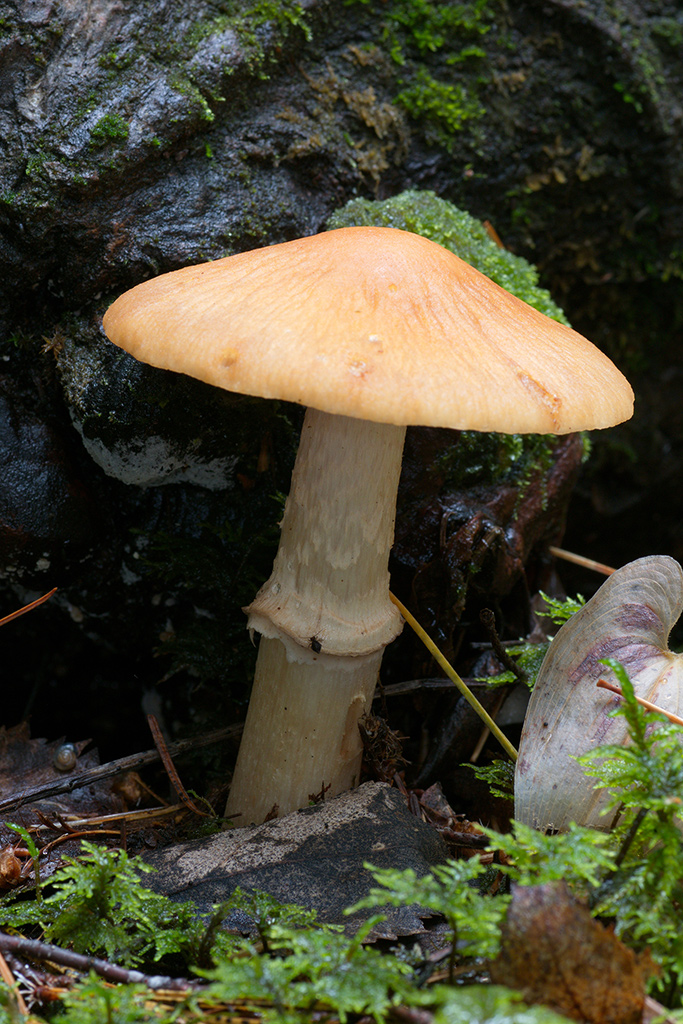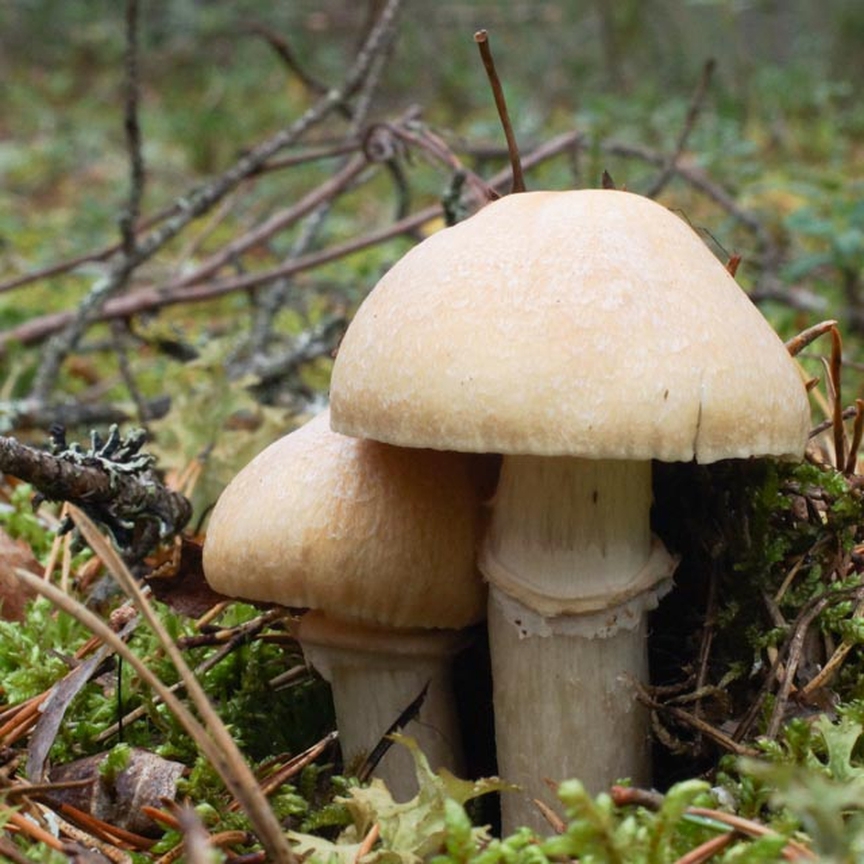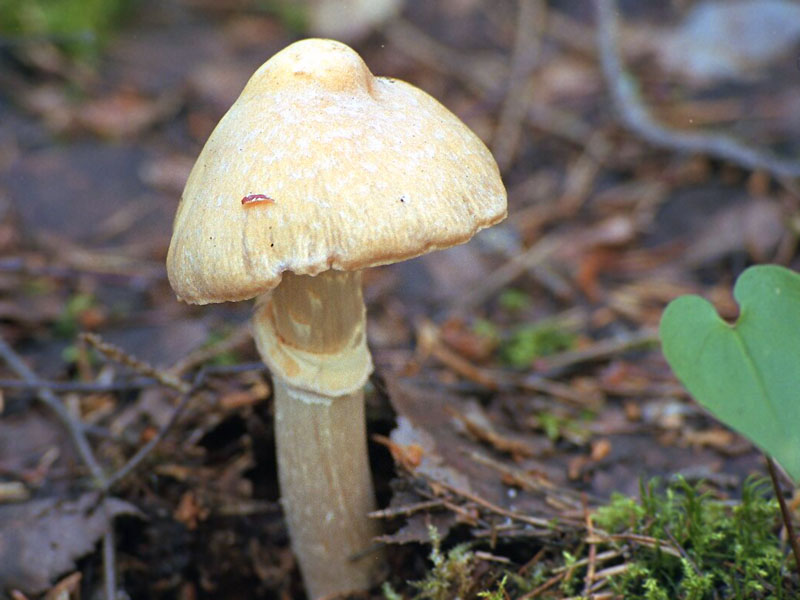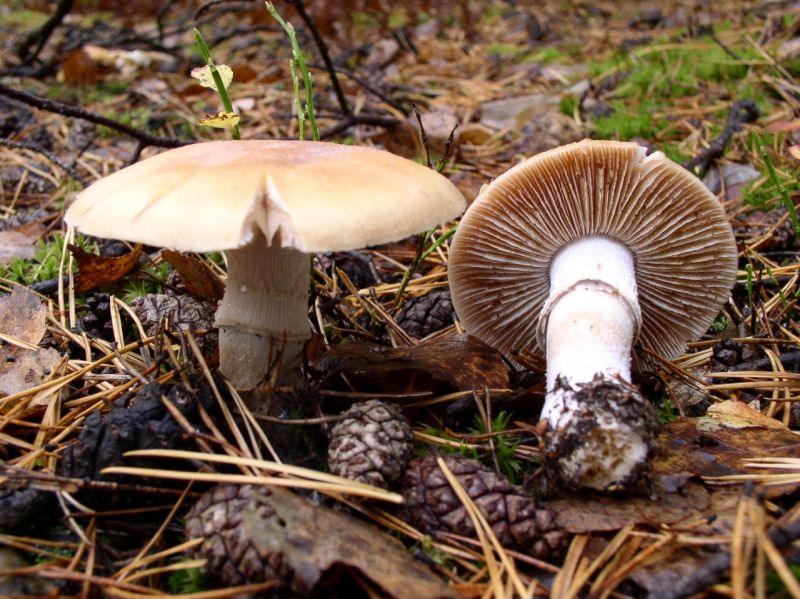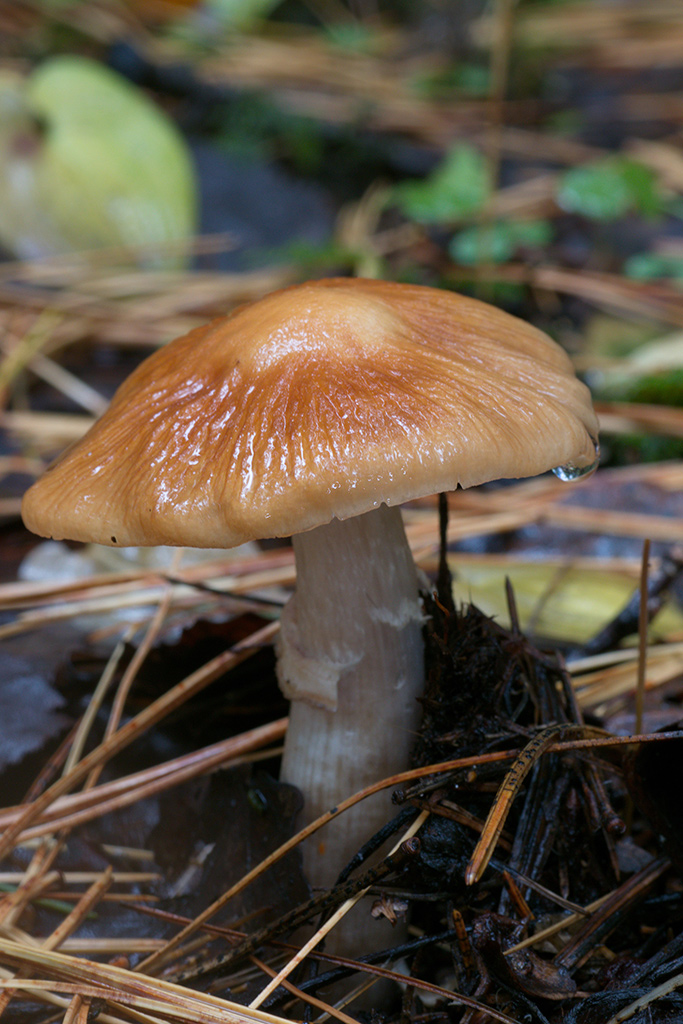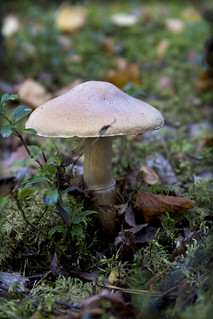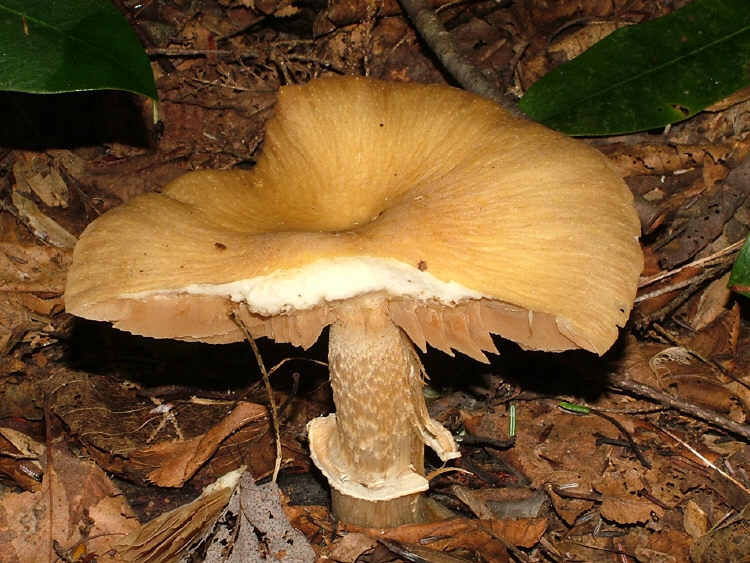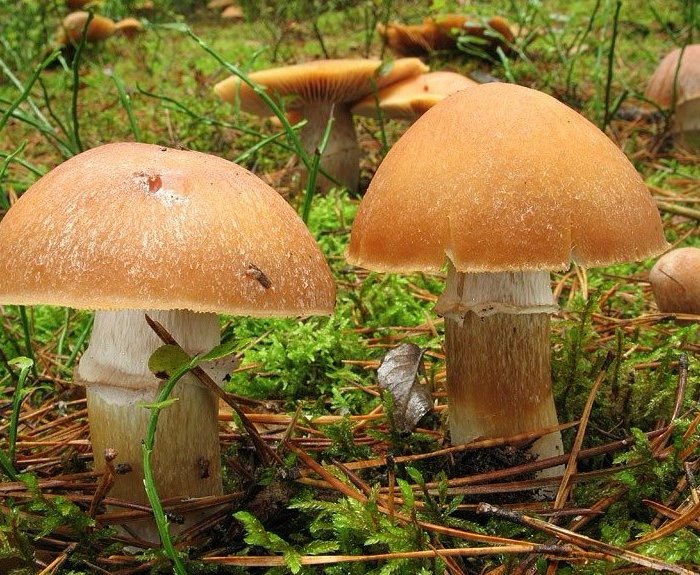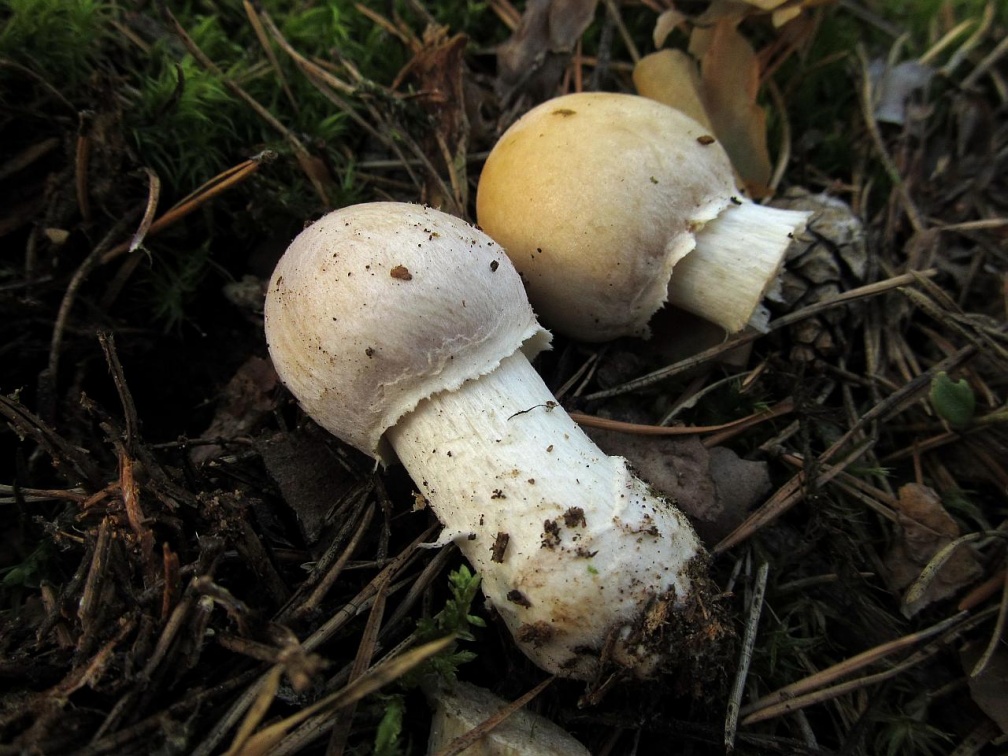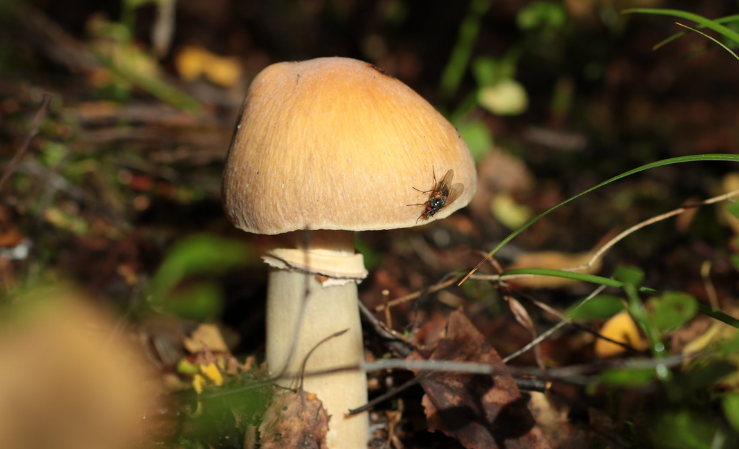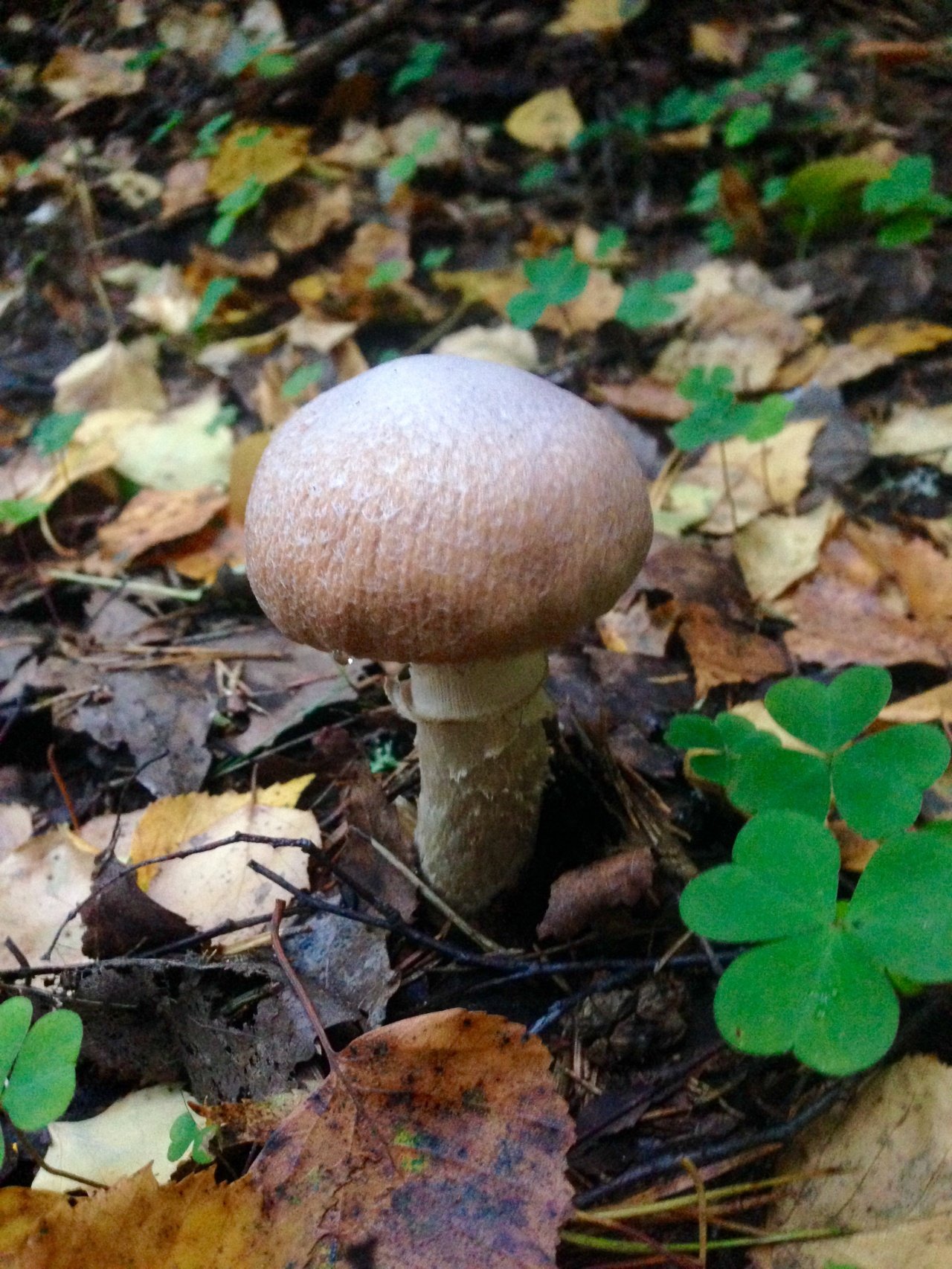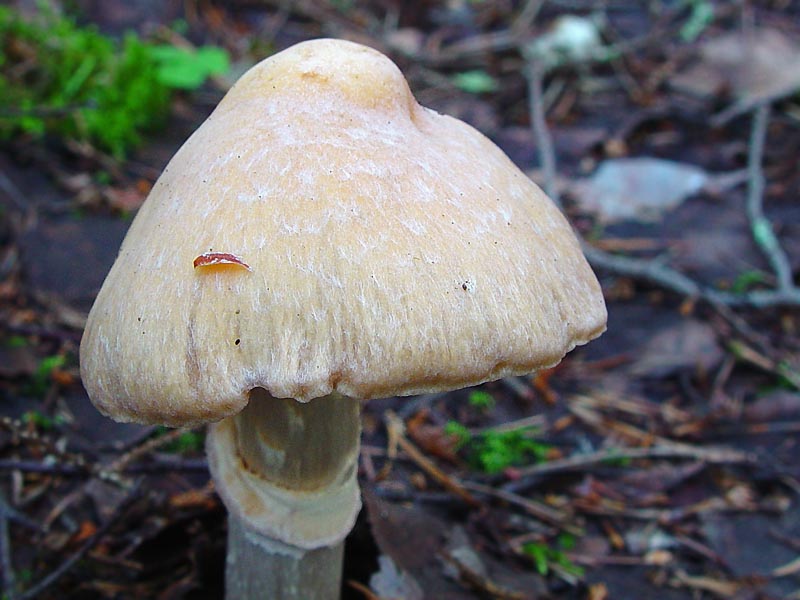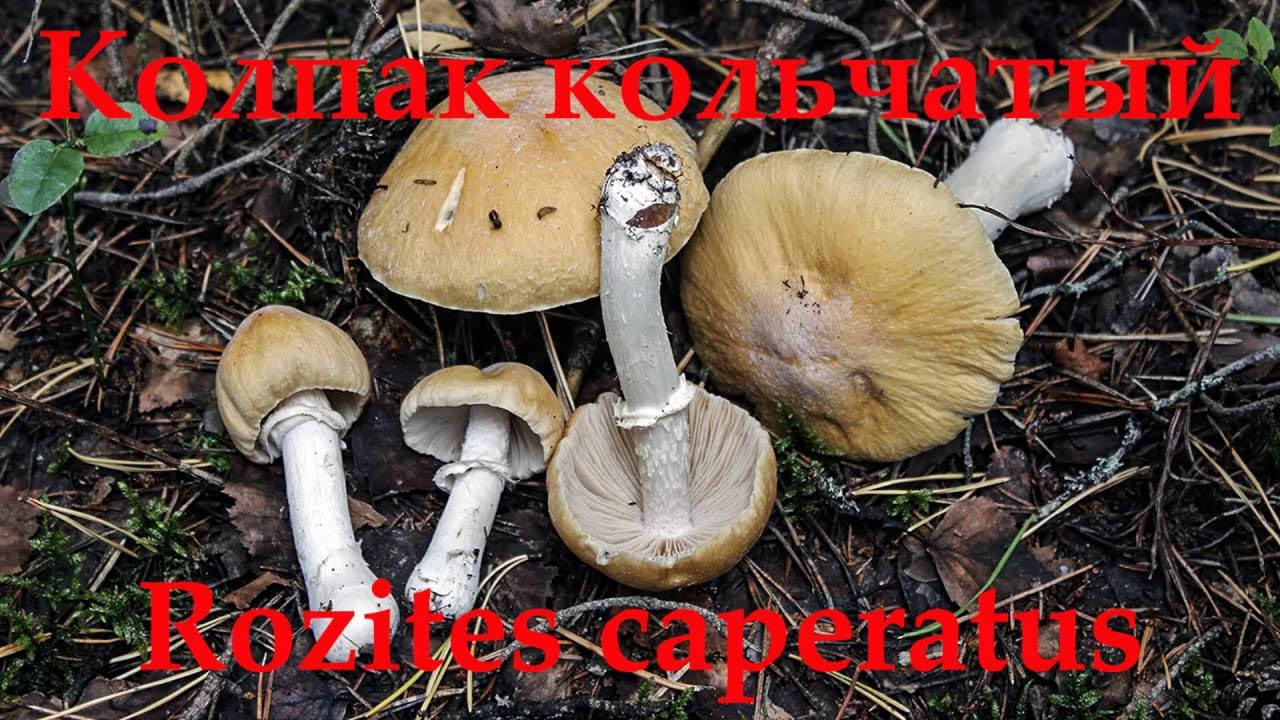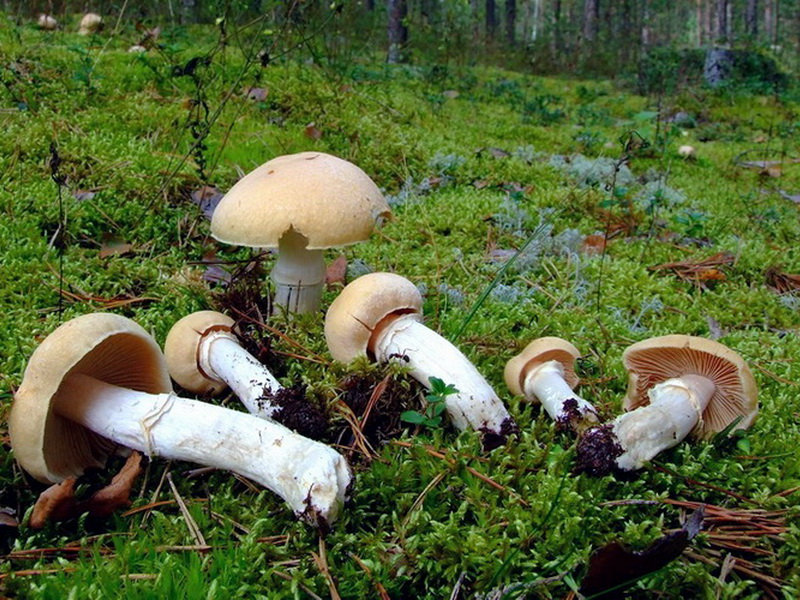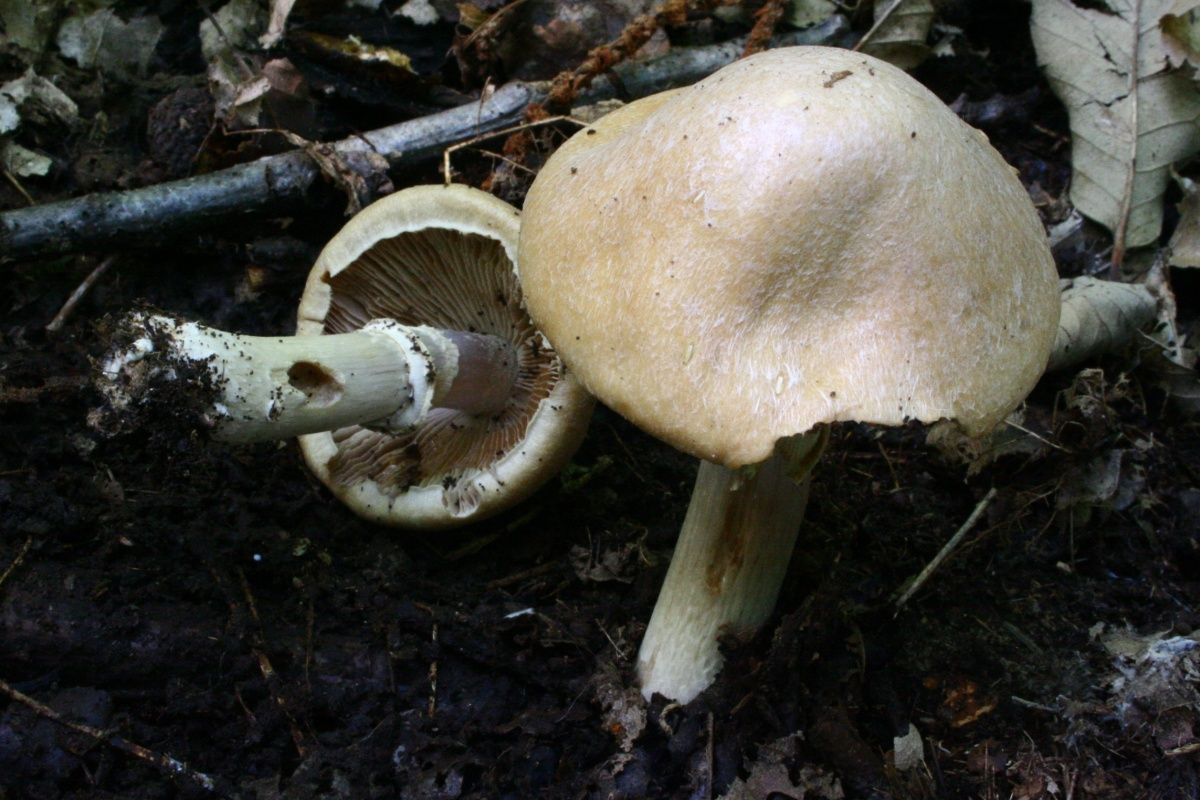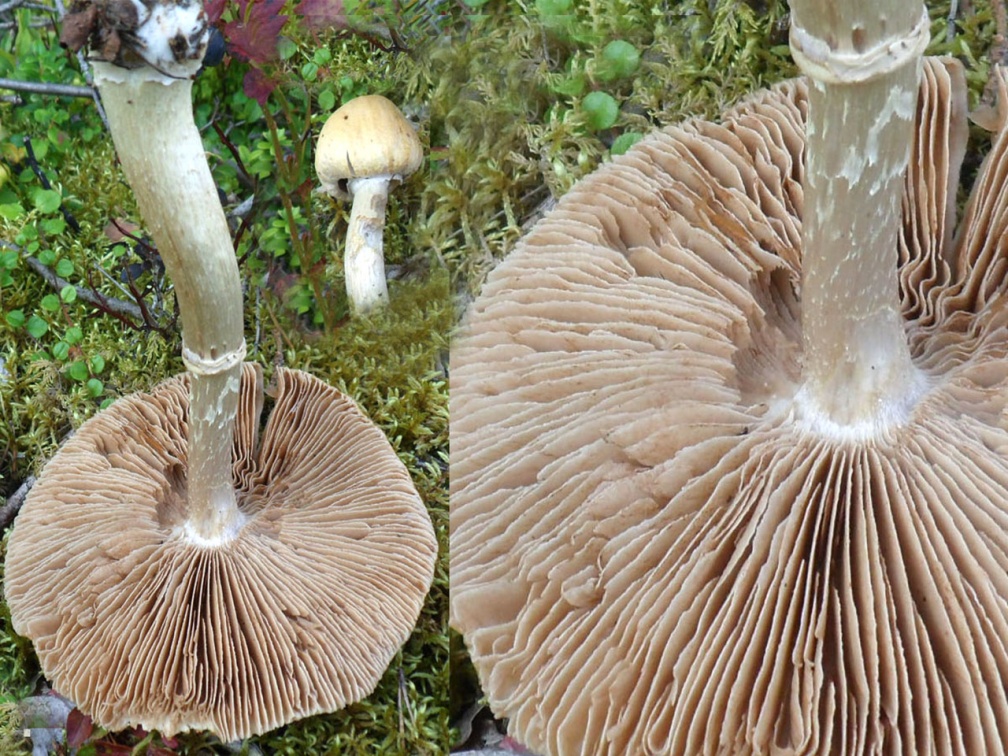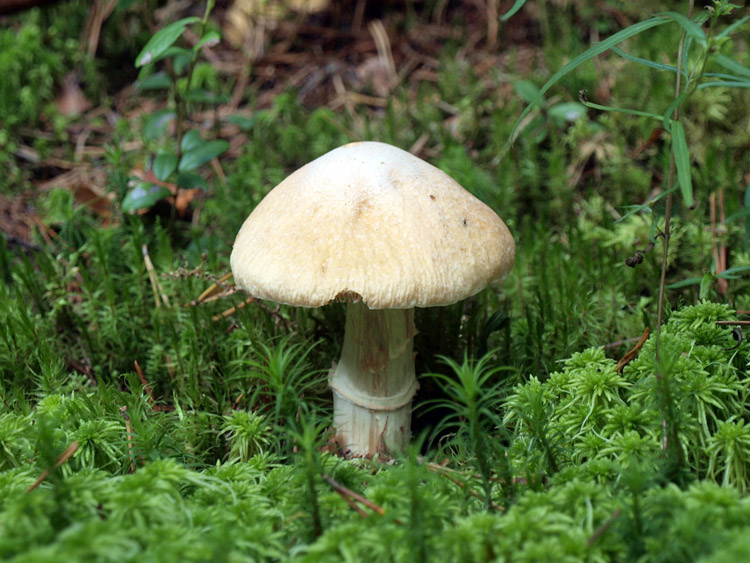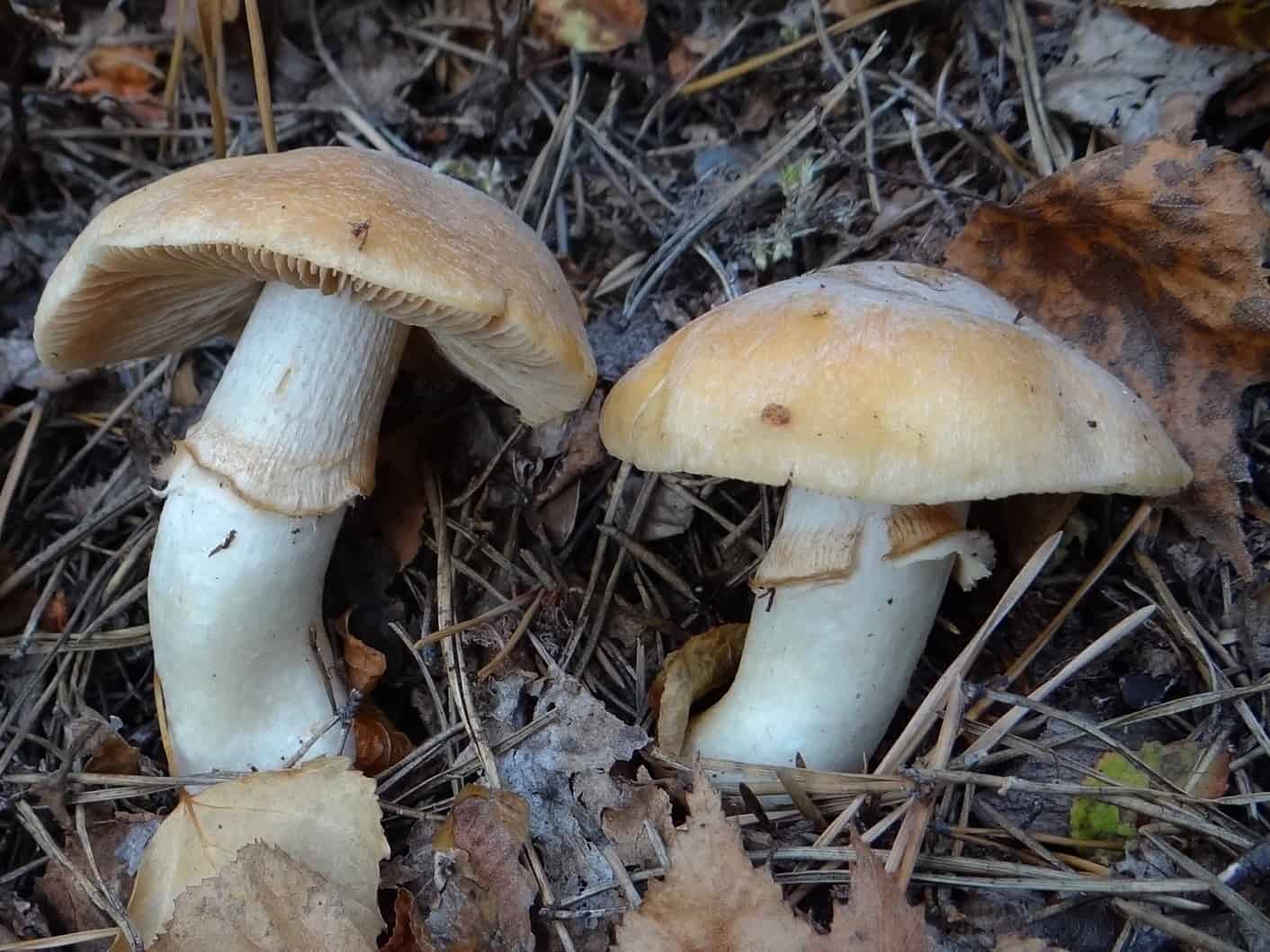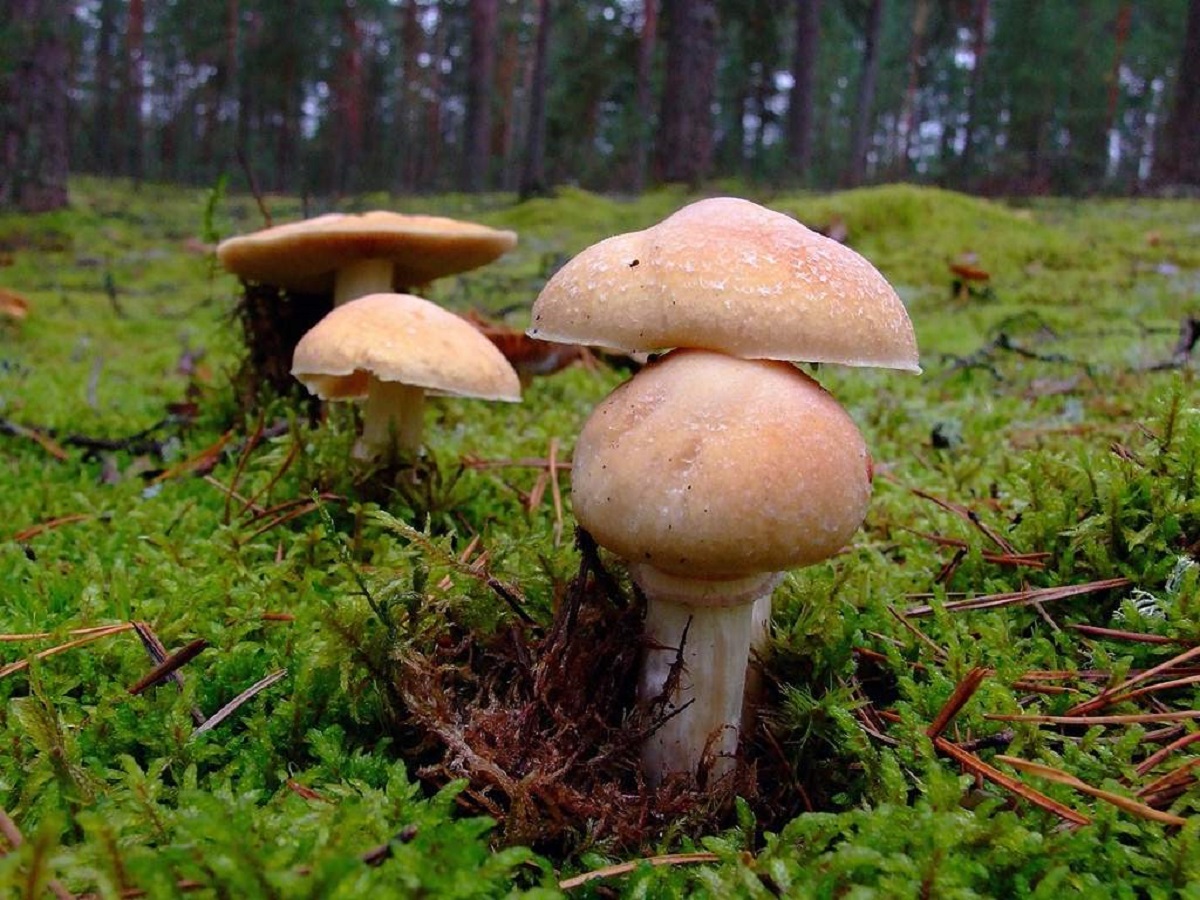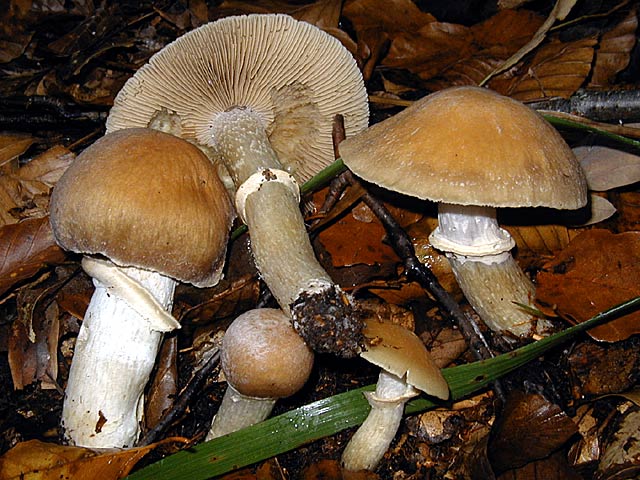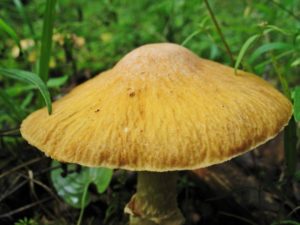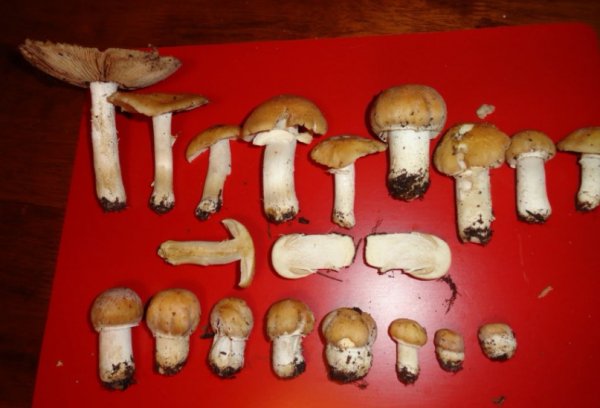One hood, two systems
Someone has already got used to it, but the ringed cap fascinates guests of the pine forest immediately and forever. Imagine such an emphatically neat mushroom, embracing a thick leg with a spindle-shaped cap, painted modestly, but surprisingly elegantly - in restrained gray tones, shimmering in the sun with a subtle mother-of-pearl shine ... Looking at such a miracle, you immediately understand why many serious people appreciate this mushroom almost not on a par with white.
This cap is good and young (photo by I. Lebedinskgo)
Or not, on the other hand. So you went to a white-moored boron to look for hogweed. Walk for an hour, walk for two - and at every step, like an element of a pattern on a white carpet, there are some disheveled gray toadstools. Shapeless hats, as if carved out of old faded floor rags, in some places expose tousled dirty gray plates to the general shame ... Everyone knows that this is not a grebe, it is, in principle, eaten, but to what depths of despair it is necessary to descend to bring from a basket of such happiness!
It's all about him. About the ringed cap. And it's all true.
And this one is bad and old (photo by I. Lebedinsky)
Description and photo of the Ringed cap
Most often, it can be found growing next to blueberries, birch, beech, shrubs and berries. The mushroom is widespread in Europe, America, Japan, and also in Russia. From Latin - Cortinarius caperatus.
What else interesting mushroom picker should know about this representative of the agaricomycete class?
Hat
Rozites dull got its name thanks to its peculiar hat. In shape, it resembles a small peculiar bell, slightly pointed in the upper part and smoothly descending downward.
This mushroom is very similar to the representative of the spiderweb family. The hat has a rusty brown tint. Depending on the age of the mushroom, as well as on the conditions of its growth, the shade of brown may change. The hat is fleshy, edible. When cut, no yellow bloom is formed, the pulp remains white or beige for a long time. There are thin stripes under the cap that separate the future of the dispute from each other.
If the mushroom is not well located in an area that is too illuminated, then the cap from abundant sunlight can become covered with microcracks and scratches, become dry, and become covered with scales.
A mushroom located in a cool and humid forest environment, on the contrary, has a rather slimy glossy cap surface. As for the spore powder, it crumbles at the end of August, at the beginning of September. Has a rusty brown tint.
The cap of young mushrooms itself reaches a diameter of 4 to 10 cm. The younger the mushroom, the more ovoid and spherical shape of the cap is provided.
Leg
The stem of this mushroom resembles a column. It does not expand or thicken towards the base, and does not taper towards the point of attachment of the cap. It has a white or grayish tint depending on age. In girth from 1 cm to 3, depending on the age of the mushroom.
Most often, a kind of skirt is located in the center of the leg, which catches the spores crumbling from under the cap. The stem also belongs to the edible elements of the mushroom. Fastens tightly to the mycelium cap. Young mushrooms have more bluish shades of the stem. In dry weather and overexposure to the sun, the substrate can become dry and brittle. Her taste is pronounced, mushroom.
Edibility
Mushrooms are edible. At the same time, you can use both his hat and leg for food. The greatest taste and benefit can be obtained if rosites are harvested in late August - early September.
Do not pick mushrooms that have external defects. The Ringed cap is very fond of worms, which are also found in the humid environment of deciduous forests. If they began to penetrate the cap or leg, then decay processes are triggered.The fungus releases harmful substances that will not be beneficial to humans. Therefore, the mushroom with traces of damage should be left in place.
Also, a mushroom that has been exposed to direct sunlight for a long time becomes inedible. Now there are cracks on his hat, and he himself is dry. There is nothing useful in this mushroom, moreover, it can also release substances that are not the most useful for consumption.
Already at the end of September, the mushroom becomes inedible, loses its taste, and its stem and cap gradually begin to turn into a slippery jelly-like mass.
Where it grows and when to collect
The mushroom can be easily found in Russia. In addition, it has become widespread throughout the European part of the continent. You can find it in Poland, the Baltic countries, Germany, France and so on.
The ringed cap is also found in North America, where it was named "bogey»Because of the close location to similar places. In Japan, the mushroom got the name "mushroom of the Turks" because of the strange associations associated with the inhabitants of southern Europe.
It has also been found in Lapland and Greenland. Rosites prefers mostly deciduous forests, however, it can also be found among coniferous thickets. Likes moderate humidity, diffused light. Settles near water bodies.
Collecting this mushroom is recommended from late August to mid-September. From September to August, this mushroom already loses its taste properties, quickly dries up due to a lack of nutrients in the soil.
However, if the fall is warm, chances are that the mushroom hike will be successful.
Cooking recipes
There are a lot of methods for preparing mushrooms, consider delicious recipes.
You can prepare a delicious preparation for the winter according to the following recipe:
- Put salt in boiling water, a tablespoon per liter of water.
- Blanch the washed caps for five to ten minutes.
- Throw the product on a sieve, rinse with cold water.
- Mix mushrooms with black and allspice, garlic, horseradish, bay leaves, dill, white mustard seeds.
- Pour 50-60 grams of salt per kilogram of the main product, cover the container with a napkin, put oppression.
- After five to ten days, the mushrooms will ferment, they can be eaten.
Transfer the snack to glass jars, store in the refrigerator.
Caps in batter
For cooking you will need:
- Caps - 500 grams.
- Eggs - 3 pieces.
- Mayonnaise - 300 grams.
- Flour - about 200 grams.
- Vegetable oil for frying.
Step by step cooking:
- The eggs are mixed in one bowl with mayonnaise.
- Flour is added to the resulting egg mixture. Mix well so that the batter acquires a thick consistency. There should be no lumps.
- The mushrooms are washed under running water, the caps are separated from the legs.
- Parts of the mushroom are dipped in batter and placed in a frying pan hot with oil.
- Fry until golden brown.
Ingredients:
- Table vinegar (9%) - 100 grams.
- Clove buds - 3 pieces.
- Allspice - 5 peas.
- Black pepper - 8 peas.
- Bay leaf - one.
- Sugar - 70 grams.
- Salt - 30 grams.
- The mushrooms are washed under running water.
- Boil water in a saucepan, put the caps in it, and boil them for 20 minutes.
- Mushrooms are transferred to a colander, cooled (you can substitute it under a stream of cold water from the tap).
- The marinade is cooked in a nearby container. Salt and sugar, the necessary spices are added to it.
- Boil the marinade for about 5 minutes, then add vinegar to it. Pour mushrooms.
- Boil the mushrooms in the marinade for a few minutes and put them in pre-sterilized jars.
- Roll them up with boiled lids, turn them over and expose (often on the floor).
- Finished pickled caps are stored in a cool place (cellar basement).
For the marinade, it is recommended to choose small mushrooms, the caps of which did not have time to open. Then the caps turn out to be crispy, and the marinade is transparent and attractive. If the caps are adults, it is better to remove the legs altogether, they are not tasty.
To get the most out of the cap mushroom, you need to learn how to choose it correctly:
- Refuse aging specimens, their taste is significantly inferior to young mushrooms. The leg is not at all edible.
- The optimal time for harvesting is from July to early August.
- Do not take a mushroom if its cap is damaged, wormy, or has black blotches.
Keeping mushrooms raw is a painstaking task. The hoods must not be allowed to come into contact with food, and even with each other. To do this, each fungus is wrapped in a damp paper towel. If you are lucky enough to bring caps from mushroom hunting, then it is better to cook them right away. The best way to store it is marinade.
We offer you to familiarize yourself with How to choose a landscape designer
If you ever try a mushroom cap, you will certainly want to grow it on your site. This kind of cultivation is perfectly acceptable. First way:
- Have a sufficient number of stumps in the garden.
- The caps of adult mushrooms are laid out on a paper sheet with the plates down.
- Spores remain on the sheet, which are poured into a container with water.
- Water with spores is shaken well and poured onto the stump.
- The hemp is periodically watered and the harvest is awaited.
Second way:
- Prepare wooden chocks, always round (more than 15 centimeters in diameter). They are taken only from freshly cut trees.
- The mycelium is thrown onto the chocks in the same way as on the stumps.
- Lumps are placed in a dark room, where the temperature fluctuates around 15-20 degrees.
- Then the chocks are placed in holes 20 centimeters deep.
- You can harvest the fruits 2 times a year for a maximum of 3 years.
Unfortunately, this mushroom is underestimated, seasoned mushroom pickers gather porcini mushrooms and milk mushrooms, not noticing less popular, but no less tasty and healthy varieties under their feet. In Europe, it is considered a gourmet product.
The ringed cap is a mushroom common in the foothill coniferous forests of the middle zone of the European part of Eurasia and North America. Caps are edible mushrooms and can be eaten boiled or fried, or used for pickling.
For those who did not know: ringed cap
For many, a suburban area is, in addition to cultivated garden plants, and the opportunity to collect forest gifts: berries and mushrooms. Now is the height of the mushroom season. Lovers of "quiet hunting" in the woods in abundance are expected by noble white, never wormy chanterelles, multi-colored boletus and boletus. Now summer mushrooms are replaced by real ones - autumn ones, here and there there are vigorous boletus, sedate milk mushrooms and their relatives are already beginning to appear - all kinds of loads. And, of course, colorful fireworks of russula - all shades, from yellow to purple.
These representatives of the mushroom kingdom are most often well known even to novice mushroom pickers.
But there are mushrooms that are much less fortunate: mushroom lovers do not know them "by sight", they take them for toadstools, and it is good if they just ignore them when picking them. But it happens that with some kind of vicious bitterness they trample their feet, knocking down their caps - for some reason, inedible or poisonous mushrooms in some cause such emotions, as if a handsome fly agaric can rush at a person and bite him if he is not quickly trampled
One of these losers is the mushroom cap. Not many of the mushroom pickers know and collect it. I even found on the Internet a kind of philosophical essay "The Tragedy of the Cap", in which the author draws parallels between the mushroom bad luck of the cap and the Russian mentality. Indeed, the mushroom is somewhat subtly reminiscent of the character of Russian fairy tales - Ivanushka the Fool. The caps, in my opinion, have the same rustic and good-natured look.
Eating
It is best to eat young mushrooms with unopened caps. In general, it is better to use only caps for cooking, since the legs are harsh, especially if the mushroom is already old.
Taste qualities
In terms of taste, it is no worse than champignon.Has a pleasant smell and taste reminiscent of meat. Its taste is best revealed in dishes made from young mushrooms.
What are they suitable for?
The chicken mushroom is used in the same form as most other mushrooms: fried, stewed, boiled, dried and pickled. It is prepared both as an independent dish and as an additive.
How to pickle
The easiest way to cook this mushroom is to pickle it. Here is a list of the ingredients you need to do this:
- ringed cap - 1 kg;
- salt - 50 g;
- bay leaf - 2-3 leaves;
- 9% table vinegar - 100 ml;
- pepper, horseradish, dill, mustard seeds - to taste.
Jars of pickled mushrooms are stored in a cool dry place.
Ringed cap is a mushroom that has excellent taste and a wide range of growth, therefore it is sold and prepared in different countries. Due to its taste, it is widely used in various dishes: soups, salads and as an independent dish.
How to cook delicious chicken
The ringed cap is classified by many mushroom pickers in the category of gourmet mushrooms, which in their taste are not inferior to the eminent and most "noble" varieties. Such mushrooms can be harvested for future use or used to prepare first and second courses. It must be remembered that mushroom blanks must be stored in a cool basement or refrigerator at a constant temperature of 0-6 ° C.
Also read: What do the gray and green tea look like and where do they grow?
Pickling
Peel the fruit bodies, separate the caps and cut into two or four pieces. Prepare a marinade from a liter of water, half a glass of 9% table vinegar, three cloves, one bay leaf, eight black pepper, 70 g granulated sugar and 30 g salt. Dip the mushrooms in boiling water and boil for a quarter of an hour, then cool quickly in running water. Cold mushrooms are dipped in a boiling marinade, and after a couple of minutes they are laid out in hot and sterilized glass jars, which are rolled up with lids.
For the preparation of all kinds of mushroom dishes, exclusively mushroom caps are used.
Salting
Rinse thoroughly in running water and boil the mushroom caps for a quarter of an hour, then cool quickly under running water and salt in layers with coarse rock salt. Typical salt consumption is approximately 350-370 g per bucket. It is allowed to shift the salted mushrooms with leaves of black currant and horseradish. Oppression is installed from above. With this method of salting, the chickens are ready to eat in about a month and a half. It is best to store fully prepared salted mushrooms in a basement or in a regular household refrigerator.
Clear and aromatic mushroom soup
After washing in running water, small mushroom caps are cut in half or into four parts, and larger ones are cut into fairly small pieces. Then you need to cut onions, parsley root and carrots into slices, then boil them in water until half cooked.
Ecology and distribution
Forms mycorrhiza mainly with conifers, but also with beech, oak, birch. In the middle lane, it is found in mossy places in coniferous, mainly pine, and mixed forests, especially in bilberry, less often in oak forests; in the north - under dwarf birches. Prefers moist, acidic soils. In the mountains, it occurs at an altitude of up to 2000 meters. Fruiting bodies usually appear in small groups.
Distributed in Western Europe, everywhere - in Belarus, in Russia it is found in the western and central regions of the European part. Season from early July to early October.
Learn not to be confused
A young cap grown in comfortable conditions is a highly recognizable mushroom. Hemispherical cap, tightly covering the leg, delicate mother-of-pearl bloom on a grayish or beige surface; carefully cutting the mushroom, you can find a thick light gray bedspread, the prototype of the ring.It is not in vain that this mushroom has long been considered one of a kind.
Cap of yesterday's day (photo by user Gregory)
Relentless time quickly takes its toll. The cap opens, retaining some kind of "filthy" tubercle in the center, and the edges become unpleasantly wrinkled, as if at some kind of fiber. Rain and sun complete the metamorphosis: the delicate mother-of-pearl coating is washed off, and the cap itself is deformed in a chaotic manner, protruding wavy plates. At this point, the cap looks like a whole bunch of old mushrooms. There are cases when, mixed with old caps, some indeterminate fly agarics of the same age were collected. Hopefully gray-pink at least.
Meet the cap
The cap is ringed, the Latin name is Rozites caperatus. The mushroom is named after the mycologist Ernest Rose, who described it. It grows in northern Europe up to Greenland, in the western part of Russia, as well as in North America. In Belarus and the Baltics, it is found everywhere and is known under the names "chicken" (basically it is called so in Belarus) - due to the fact that stewed or boiled it slightly tastes like chicken meat, podolotnik - because it likes to grow in humid places , "Turk" or "Gypsy" - under this name is known in Lithuania and Latvia. Why the Turks are unknown. The mushroom is also common in the North-West and in Finland, where it is called "grandmother's cap".
Where it grows
The ringed cap is found in coniferous and mixed forests. It forms mycorrhiza with pine, spruce, oak, birch or beech. Prefers mossy, humid places and is often found in blueberries. Caps most often grow in large groups, which contain mushrooms of all age categories, from the youngest to the patriarchs. It is very easy to collect them, especially since the fruiting season of the mushroom is very long: from July to almost the end of October. And given that there are not so many applicants for this mushroom, it is not difficult to collect a full bucket of caps.
What does it look like
The name "cap", in my opinion, most accurately characterizes this representative of the kingdom of mushrooms: the shape of his cap at a certain period of development resembles this particular headdress.
Young mushrooms have a more accurate cap shape - spherical or ovoid. With the growth of the mushroom, the cap takes the form of a cap. Sometimes there are fungi with caps-caps, dressed on one side - squeezing between the blades of grass and twigs, the mushroom cap moves dashingly. In older mushrooms, the cap fully straightens to a flat state with a diameter of up to 150 mm, and in very old mushrooms, its fields begin to bend upward. In this case, the edges of the cap are cracked. Cracks on the cap also appear in dry weather.
The surface of the cap of the cap is a straw-yellow hue, lighter in youth, and darkening towards the ocher color towards the end of life. In general, the mushroom has a surprisingly pleasant appearance: both visually and tactilely. The skin on the cap is cool, slightly wrinkled, as if velvety: caperatus means "wrinkled" in Latin. There is no slime on the mushroom even in rainy weather. In young fungi, the top of the cap is coated with a pearlescent coating. Sometimes young caps even cast a delicate lilac shade. The leg of the cap is strong, with a thickening in the lower part. With a thickness of 10 to 30 mm, it can grow quite long - up to 150 mm. A ring remains in the upper part of the leg - the remains of a blanket attached to the edges of the cap while the mushroom is still young. The ring on the leg is one of the distinguishing features of the mushroom, by which you can recognize the cap.
Above the ring on the leg, there may be small scales of the same color as the leg itself. The cap plates are loose, of different lengths, rather rare, of a light beige shade in young mushrooms and darken to the color of clay in old age. In old mushrooms, the plates are very fragile. Spore powder of ocher color.
Ringed cap (Cortinarius caperatus)
- Other names for the mushroom:
- Swamp
- Chicken mushroom
- Turk mushroom
Synonyms:
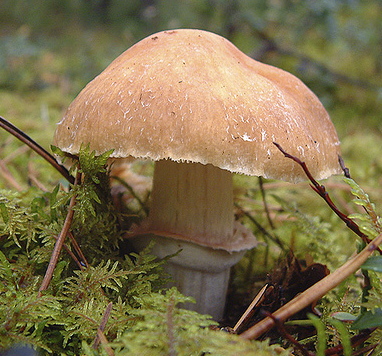 Spreading:
Spreading:
The ringed cap is a species typical primarily of forests on the mountains and in the foothills. In mountain coniferous forests on acidic soils, it grows most often from August to October. It is harvested, as a rule, next to blueberries, low birches, less often in deciduous forests, under a beech. Apparently, he forms mycorrhiza with these rocks. This mushroom grows in Europe, North America and Japan. It is found in the north, in Greenland and Lapland, and in the mountains at an altitude of 2,500 meters above sea level.
Description:
The ringed cap is very similar to cobwebs and was previously considered one of them. Its rusty-brown spore powder and almond-shaped warty spores are the same as those of cobwebs. However, a ringed cap never has a cobweb veil (cortina) between the stem and the edge of the cap, but there is always only a membrane membrane, which, breaking apart, leaves a real ring on the stem. At the bottom, near the ring, there is still an inconspicuous film remnant of the veil, the so-called hood (osgea).
The ringed cap is somewhat similar (mainly in the color of its fruiting bodies) to some species of voles (Agrocybe). These are, first of all, the hard vole (A. dura) and the early vole (A. prhaesokh). Both species are edible, they grow abundantly in spring, sometimes in summer, most often in meadows, and not in the forest, on garden lawns, etc. Their fruit bodies are smaller in size than that of the ringed cap, the cap is thin, fleshy, the leg is thin , fibrous, hollow inside. The early vole has a bitter flour taste and a flour smell.
Young mushrooms have a bluish tint and a waxed, later bald surface. In dry weather, the surface of the cap cracks or wrinkles. The plates are attached or loose, sagging, with a somewhat serrated edge, whitish at first, then clay-yellow. The leg is 5-10 / 1-2 cm in size, off-white, with a whitish membranous ring. The pulp is white and does not change color. The taste is mushroom, the smell is pleasant, spicy. Spore powder, rusty brown. Spores are ocher yellow.
The cap has a ring-shaped cap with a diameter of 4-10 cm, in young mushrooms it is ovoid or spherical, then flattened, with a color ranging from clay-yellow to ocher.
Note: This is a very high quality mushroom that can be cooked in many different ways. It tastes slightly like meat. In some countries, it is even sold in the markets.
Ring cap - Rozites caperatus
Written by Nikolay Budnik and Elena Meck.
The ringed cap, oddly enough, belongs to the cobwebs. It was named a cap, probably because the mushroom cap looks like a dashing cap pressed on a leg. And it is named ringed because of the well-visible ring on the leg.
Previously, we collected this mushroom, and now we take it only occasionally, although it is considered not only edible, but even (according to some authors) delicious. The reason for this is the abundance of other mushrooms at this time.
And ringed caps grow on Ulom Zheleznaya from the beginning of August to the end of September and are sometimes found in very large quantities. True, no one collects them from us.

1. Ringed cap is a rather large fleshy mushroom.

2. You rarely meet him alone.

3. Usually the ringed cap grows in large groups.

4. It happens that mushrooms just overlap each other.

5. It is best to pick medium sized mushrooms.

6. Not only hats are tasty and juicy.

7.. but also the legs of the caps.

8. Mushrooms appear on Ulome Zheleznaya in early August.

nine. . and grow to snow.

10. Most often, ringed caps can be found in a pine forest.

11. Sometimes caps grow in pine and spruce forests.

12. Often, mushrooms form large groups. We have counted 26 caps in this photo.

13. Often only the caps stick out of the green moss.

14. Occasionally ringed caps can be found in a mixed pine-spruce-birch forest.

15. Mushrooms are of medium size.

16. Here you see young and old caps.

17. This mushroom is very young.

18. And these are middle-aged mushrooms.

19. These caps are already out of date.

20. This is the height of the old mushroom.

21.A characteristic feature of the ringed cap is a mother-of-pearl coating on the cap.

22. This makes the top of the cap look almost white.

23. The folded and uneven surface of the cap remains at any age.

24. This is especially noticeable in young mushrooms.

25. In young mushrooms, the edges of the cap are strongly bent, and it has an almost spherical shape. Gradually, the edges are straightened.

26. In old age, ribbing is visible along the edge of the cap.

27. From rains and frosts, the cap sometimes loses its mother-of-pearl coating.

28. But usually, even in old age, it is visible.

29. The plates of young mushrooms are covered with a film blanket.

30. Gradually it breaks off from the cap, exposing the plates.

31. Young mushrooms have white-ocher plates.

32. Gradually they darken.

33.. acquiring a clay tint.

34. This is how the plates are attached to the leg.

35. The stem of the mushroom is rather high, cylindrical.

36. Sometimes it expands knieu.

37. Flakes are often visible in the upper part of the stem, forming a moire pattern.

38. This is the leg of an old mushroom.

39. The film covering the plates of the young mushroom comes off, forming a ring on the stem.

40. This is how the ring looks up close.

41. This is how the leg is attached to the ground.

42. The leg is solid, incomplete.

43. The pulp of the mushroom is firm and tender.

44. Unfortunately, she is often wormy.

45. Legs are especially wormy.

46. In our opinion, the pulp of the ringed cap acquires a peculiar smell during cooking.

47. We don't like this smell.

48.. therefore, we eat the ringed cap only in a mixture with other mushrooms.

49. In the West, this mushroom is considered a delicacy.
A small roller about a ringed cap
And in the film, in which we show the preparation of the Ringed Cap. We liked the mushroom.
Similar species of mushroom
But you should carefully collect ringed caps and know well their appearance and special signs, because they can be confused with some poisonous lamellar mushrooms - some varieties of fly agaric, as well as with pale toadstool. Therefore, you need to know how to recognize edible caps.
The main differences between edible pistils:
- the cap of this mushroom is of a rounded or slightly convex shape of brown (or rusty) color, in the center of the bulge it is covered with a coating that looks like flour;
- there are no flakes on the surface of the cap, and large scales found in poisonous mushrooms, thin scales can only be along its edge;
- old mushrooms always have a skirt - a blanket in the upper third of the leg, and in young chickens this film is connected to the edge of the lower part of the cap;
- on the lower part of the cap, the plates adhered to the stem are yellow or rusty.
Old chicken mushrooms always have a skirt.
What does it look like
The cap of the ringed cap varies from 5 to 15 cm in diameter. In a small mushroom, the cap is shaped like an egg, but as it grows, it straightens into a hemispherical shape with edges curved inward. It is available in gray-yellow, straw-yellow or ocher color. It has a wrinkled surface and often cracks.
Did you know? There are so many varieties of mushrooms on our planet that scientists still cannot give an exact figure. It is believed that there are about 6 types of mushrooms for one type of plant.
The plates are not too thick, have a yellowish or light brown color in the young mushroom and change it to brown-ocher as it ripens.
The leg of the ringed cap is white, sometimes yellowish over the mushroom ring. The length varies from 2 to 12 cm. The upper part of the leg has pronounced yellowish scales. Spore sac - from rusty brown to ocher color. Spores - 12 by 8 microns ocher color.
We offer you to familiarize yourself with Mushrooms in a deciduous forest in autumn
In order not to confuse these edible "gifts of the forest" with poisonous ones, it is necessary to have a good idea of what the woodworms look like. The cap is rounded, ovoid or almost spherical in shape. Its color is pinkish with a brown tint, very similar to a chicken egg shell worn on a leg.The diameter of the cap of a young mushroom is up to 4-4.5 cm, in old mushrooms it can reach 9-11 cm.
The surface of the cap is covered with wrinkles and a light-colored bloom, similar to flour
With age, the shape of the cap changes: in the center it becomes more convex, therefore it is often compared to a wide-shaped cap. The edges of the cap in young chickens, which are attached to the upper end of the leg, eventually diverge to the sides, and the film breaks. And in the upper part of the leg, a frill is formed, the edges of which are torn, lowered down.
On the reverse side of the cap, plates are visible, on which spores of this fungus begin to grow over time. In young fruit bodies, the color of the plates is white or yellowish. But the older the chicken, the darker the color of the plates becomes. After opening the cap, they turn yellow, and after the ripening of the spores, the plates acquire a rusty color.
Where and when to collect
Ringed caps are most often found in climatic temperate natural zones. They can be found throughout Asia and Europe, Japan, Canada and the United States. They can be found both in the mountains at an altitude of more than 2 thousand meters, and in dwarf birch forests of northern latitudes. Most often they create mycorrhiza with conifers on mossy soil.
The development of mycelium is favorably influenced by podzolic soils of deciduous and mixed forests. Sometimes mushrooms can create huge plantations, but this is rare. Basically, they form numerous compact groups. They thrive best in acidic soils. In Central Russia, chickens are found along the edges of swampy lands, where there is high humidity and moss is actively growing. You can also meet them in the swamps of Belarus. You can collect them from early July to early October.
And finally, the scariest part of our story
The ringed cap is not just edible, but also very tasty, completely versatile and trouble-free mushroom. He does not require any preliminary caresses - he immediately asks from the forest for a frying pan; and in the soup, according to fans, it is by no means a stranger. Given the fertility of the fungus, the cap is ideal for blanks for future use; it is actively pickled and salted, mainly in a hot way. In the circle of amateurs it is often called "chicken".
A chicken is not a chicken, but a beautiful mushroom (photo by I. Lebedinsky)
I got my first caps fifteen years ago. They were really they - young, compact, mother-of-pearl caps; not prey - a fairy tale! I cooked, as usual, had supper - and the next day to work, one super important (on a small business scale) meeting after another ...
All these meetings I failed, as well as the next day's meetings. Generally failed everything in the world. "Morning after the Cap" was full of surprises. Calling what happened to me "allergy" is like calling today's whites "a little wormy." During a working day, I ate several packs of "Suprastin" (there was no point in modern anti-allergic drugs, only hardcore) and still every half hour I felt an unbearable desire to howl and roll on the floor - my reaction to the caps was so intolerable and all-embracing ...
Never before (and after) this has never happened to me. Nowhere and never have I heard or read about such an action of the ringed cap. But it was. Since then, I have hesitated to repeat the experiment with the cap, and I avoid other cobwebs.
Well, there are no such coincidences? ..
Sorry, I can't shoot chanterelles. (Now someone will say - yeah, but you know how to do everything else.)
Mushroom cap ringed: photo and description
In the photo, a mushroom Ringed cap
The ringed cap (Rozites Cortinarius caperatus) is popularly called "chicken".
The name is explained very simply: the cap of a young mushroom resembles a cap, and it has a white ring on its stem. True, many other mushrooms are also very similar to caps of various styles, exhibited for better viewing on stands in the form of mushroom legs. No wonder the upper part of the mushroom is called the cap. It is more difficult to explain why the name-keen people compared the mushroom to the poultry.Maybe its taste is somewhat reminiscent of chicken. Or maybe because this mushroom is usually very clean on the outside, forest debris almost does not stick to its cap, as if sprinkled with mother-of-pearl powder. Here is the association with a neat chicken - a good owner has nowhere to get dirty.
Not everyone, even experienced mushroom pickers, knows about the high culinary advantages of this mushroom. For example, the famous Belarusian naturalist writer and mushroom expert Dmitry Bespaly in his book "With a Full Basket" only mentions the existence of such an edible mushroom. Many people generally consider him suspicious. There are also certain reasons for this: to some extent, the cap resembles a deadly poisonous pale toadstool, primarily with its ring on the leg.
That is why it is best to get acquainted with this mushroom with the help of an experienced person who collects caps not for the first time and knows them well.
The mushroom is edible.
The cap is up to 3-10 cm, at first pistil-shaped, then spherical-closed and, finally, open, smooth, wrinkled and cracked when dry.
Experts pay attention to the peculiar coloring of the top of the cap of the ringed cap. It is necessarily yellowish, light brown in color and as if slightly covered with pearl dust, which is why it has a peculiar radiant shade.
It is distinguished from other lamellar mushrooms and from the same pale toadstool by the clayey, brownish color of the laminae, lighter in young fungi and saturated in old ones. If it seems that the plates are rather gray than light brown, then it is better not to take such a mushroom at all, until you learn to recognize the cap in any setting.
As you can see in the photo, the leg of the ringed cap is long, up to 12 cm high, up to 3 cm in diameter, with a whitish ring in the form of an attached thin film:
The stem is even, dense, yellowish, slightly scaly above the ring, at the base with a tuber remnant, usually disappearing or hardly noticeable.
The pulp is yellowish with a pleasant smell and taste. The cap is not inferior in taste to champignons.
It grows very abundantly in pine forests among mosses, on high-peat soil and in spruce forests on acidic soil. There they grow in large companies, although always at some distance from each other. Most often, especially in the depths of the forest, chickens reach a small size, with age the caps become flat, no larger than a large apple in diameter. But sometimes there are unusually many of them.
Fruiting from July to October.
It differs from inedible cobwebs (Cortinarius) in the absence of an unpleasant odor and in the presence of a well-developed ring with a double edge on the leg.
See what a ringed mushroom cap looks like in these photos:





